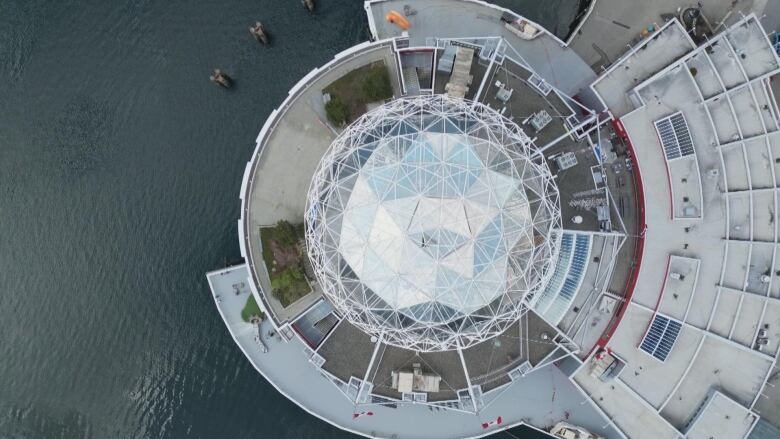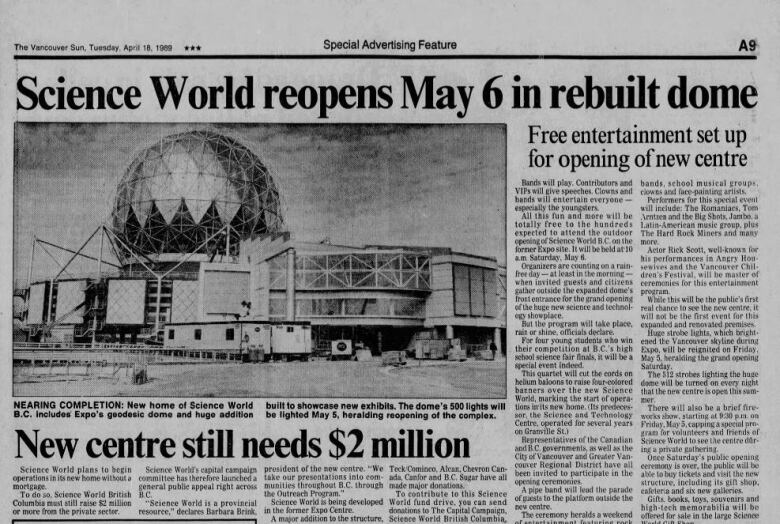Why post-Expo decisions more than 35 years ago plague Science World and the land next door today
Science World wasn't originally built to last, but its popularity led to the decision to preserve the building

David Eby came to Science World with all the enthusiasm of a premier making a good news announcement.
"It's bring your kid to work day here with my son Ezra," he said, motioning to one of the gaggle of young children who also attended the news conference announcing $20 million for Science World.
"I love any chance for my job to seem cooler to Ezra than it actually is. And for some reason, he didn't want to come to the council of forest industries meeting or the insurance brokers dinner."
As one of the favoured places for field trips in the province, Science World is popular with kids. And as potentiallythe most iconic building in Vancouver, it has plenty of nostalgia with adults.
But given all that, why had Science World fallen into such poor condition, with a leaking roof, lights that haven't been switched on for a year, a faulty electrical system and closed exhibits?
The answer partly lies in the pandemic, and partly in past management choices.
But it also lies in the convoluted structure of Science World both from an organizational standpoint and an architectural one.
Saved by popular demand
"The challenges here and the opportunities here started with the decision originally to build a temporary dome," said Eby, in defending why it took so long for the government to step up to the table.
Indeed, Science World was originally known as the Expo Centre, one of several structures created for Expo 86, the summer-long world fair that transformed Vancouver's waterfront and brought SkyTrain to the region.
Originally, it wasn't built to last according to a Vancouver Sun article at the time, the B.C. Pavillion (later known as the Plaza of Nations) was set to be the "permanent legacy of Expo to Vancouver."
But after its popularity during Expo and a push by the city's Arts, Sciences & Technology Centre (ASTC), a new decision was made: preserve the building, with various levels of government spending around $15 million to turn it into a permanent structure and convert it to a science-first tourism and educational facility.
However, that didn't change the fact the core of the building wasn't meant to last.
"I want to give huge credit to Science World and their team for extending the life of this dome beyond the originally planned six months, to here we are 36 years later," said Eby.
"Like so many of the infrastructure challenges we face across the province, it has been neglected for too long."

Charity can't leverage the land
There's also the decision aroundhow Science World would be managed.
After Expo, it was decided ASTC would run the facility as a charity, but the city would retain ownership of the land and the province would retain ownership of the physical building.
In theory, it created a partnership where two levels of government were invested in Science World.
In reality, it created a jurisdictional grey area, with Science World unable to leverage the building or land to raise revenue, or the ability to take on debt to tackle infrastructure issues.
"There's only so much money that can go in from a charity into big infrastructure challenges like this," said TracyRedies, Science World CEO, who didn't contest a claim that Science World required up to $80 millionbeyond what was announced by Eby.
"We hope people are a lot more knowledgeable of the fact that we are a charity. We don't own this building. We don't own the land. We do need the support of government to keep this iconic institution going for generations for British Columbians."

Time for 'creative' approaches forward
Ironically, Science World is next door to another political quagmire that began due to decisions made around the Expo Lands more than 35 years ago.
The giant parking lots to the north of False Creek were part of the sale of the entire Expo Lands spanningScience World to Yaletown to Li Ka-shing in 1988 for $320 million.
The land has been held by Concord Pacific since, with the lack of development of the parking lots currently the reason the city hasn't started work on taking down the viaducts.
"I think at the time it was the best bad decision the province could make," said Vancouver historian John Atkin, pointing out that the B.C. government selling the land to one bidder allowed for a cohesive development plan for Yaletown.
Whatever the reasonsgovernments took a less active role in the Expo Lands, it resulted in complicated questions at the edge of False Creek that they're now dealing with in new ways.
"I certainly like to see us be able to make some movement on moving forward on delivering more access to the waterfront," said Vancouver councillor Sarah Kirby-Yung.
"[It's] been more than a generation. So yes, I think it's time to talk about creative ways to move that forward."












_(720p).jpg)


 OFFICIAL HD MUSIC VIDEO.jpg)
.jpg)



























































































